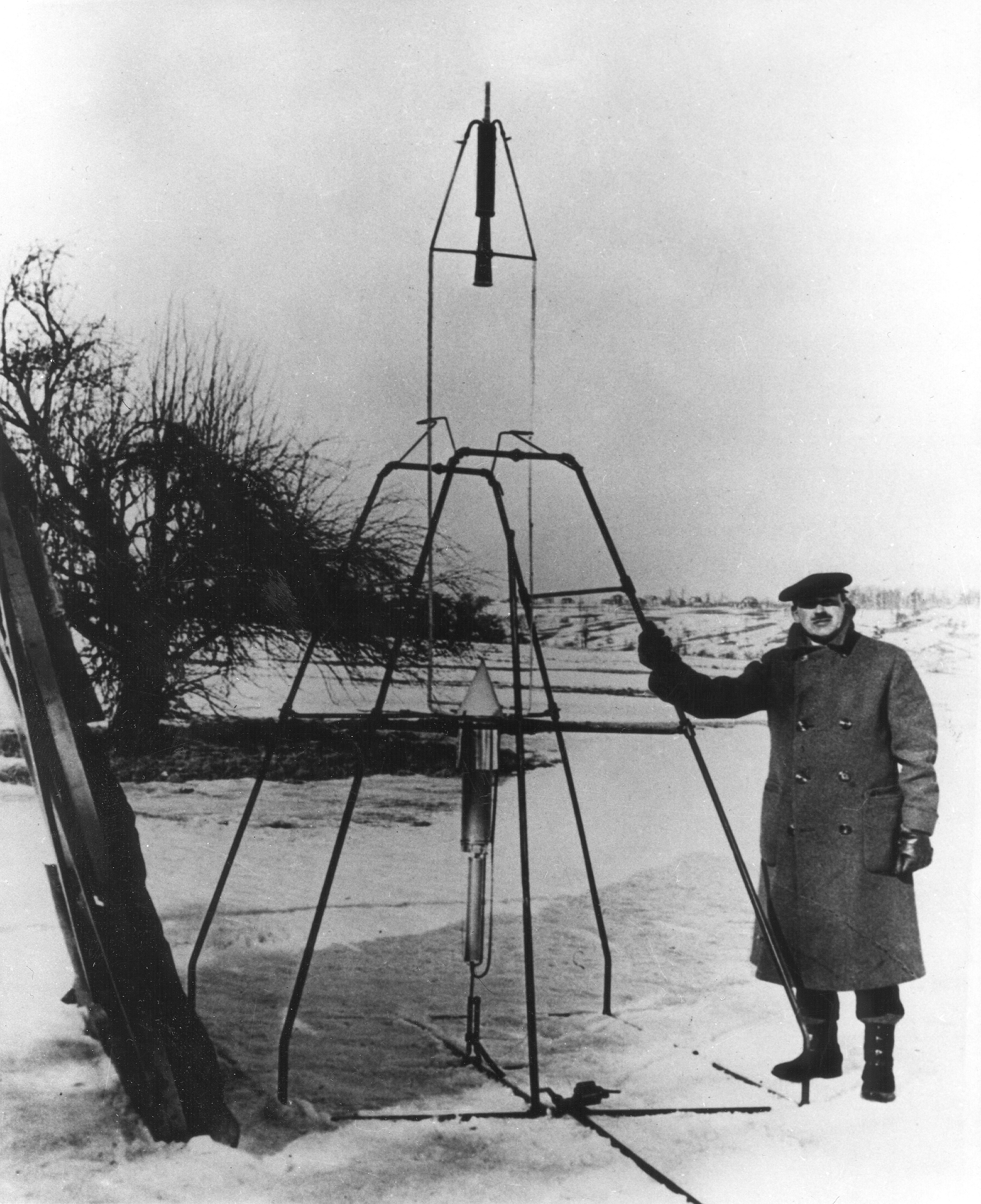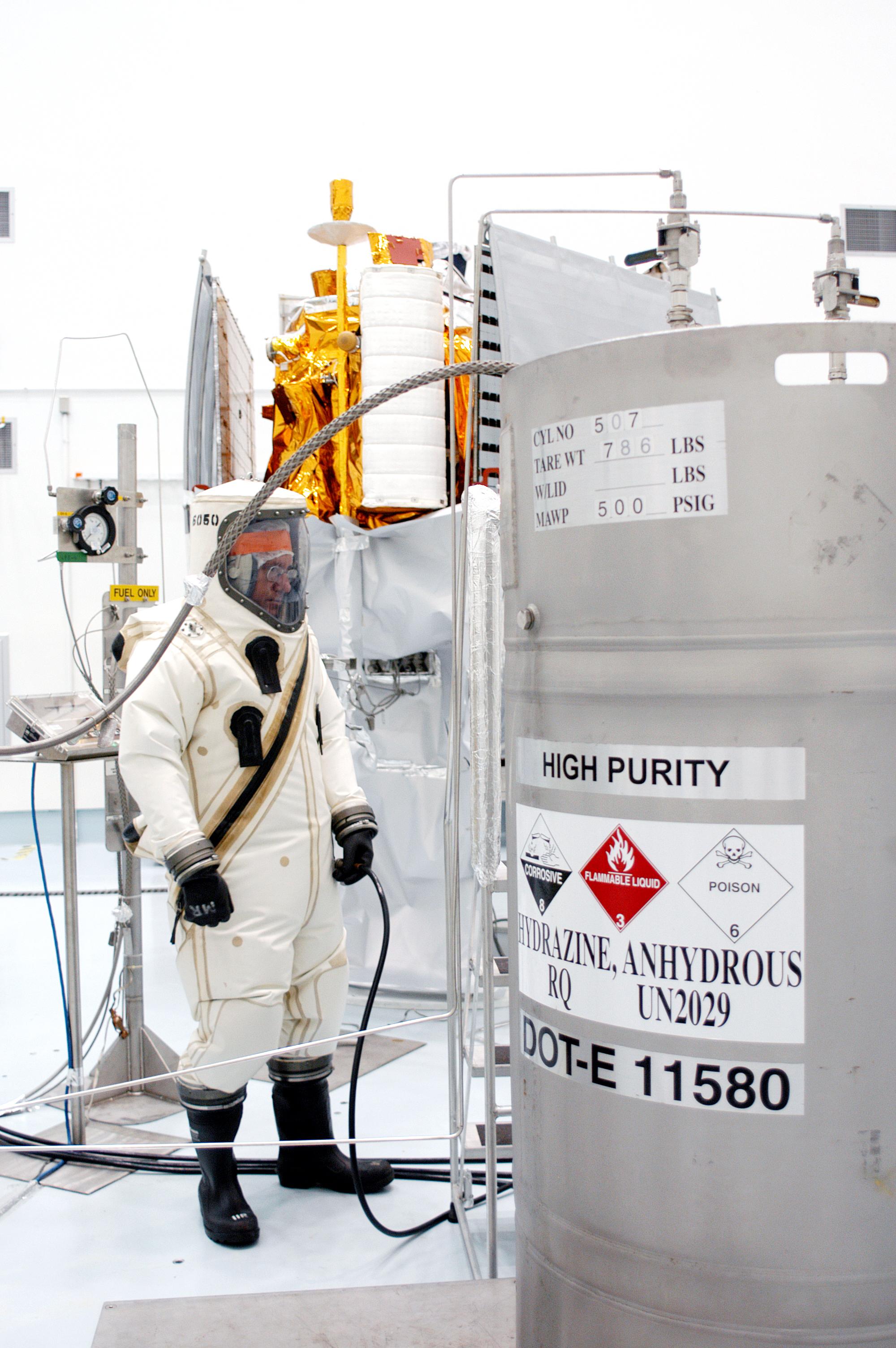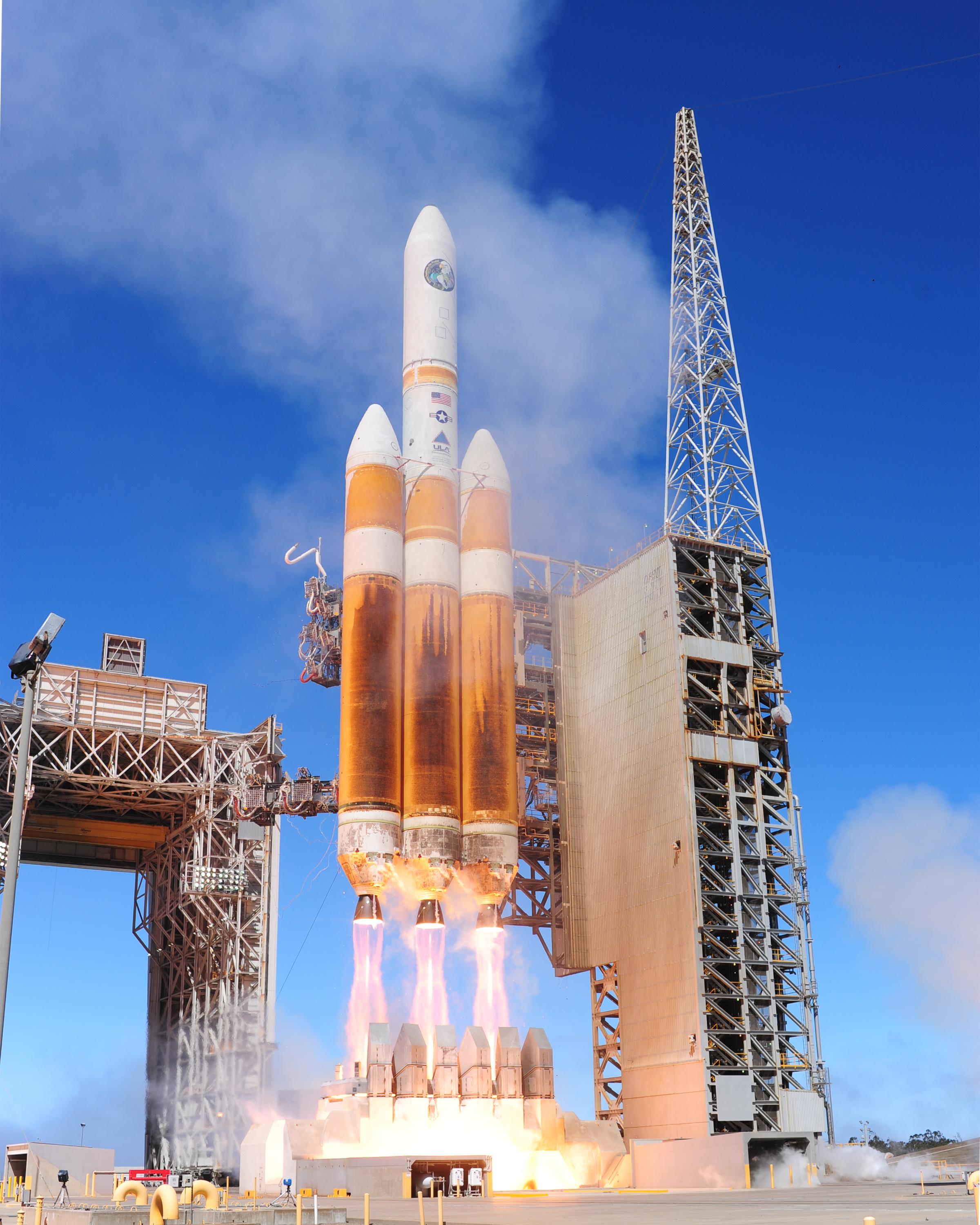|
UDMH
Unsymmetrical dimethylhydrazine (abbreviated as UDMH; also known as 1,1-dimethylhydrazine, heptyl or Geptil) is a chemical compound with the formula H2NN(CH3)2 that is primarily used as a rocket propellant. At room temperature, UDMH is a colorless liquid, with a sharp, fishy, ammonia-like smell typical of organic amines. Samples turn yellowish on exposure to air and absorb oxygen and carbon dioxide. It is miscible with water, ethanol, and kerosene. At concentrations between 2.5% and 95% in air, its vapors are flammable. It is not sensitive to shock. Symmetrical dimethylhydrazine (1,2-dimethylhydrazine) also exists, but it is not as useful. UDMH can be oxidized in air to form many different substances, including toxic ones. Synthesis In 1875, UDMH was first prepared by Emil Fischer, who discovered and named the class of hydrazines, by reducing N-Nitrosodimethylamine with zinc in boiling acetic acid. Fischer's student Edward Renouf later studied UDMH more extensively as part ... [...More Info...] [...Related Items...] OR: [Wikipedia] [Google] [Baidu] |
Bipropellant
The highest specific impulse chemical rockets use liquid propellants (liquid-propellant rockets). They can consist of a single chemical (a monopropellant) or a mix of two chemicals, called bipropellants. Bipropellants can further be divided into two categories; hypergolic propellants, which ignite when the fuel and oxidizer make contact, and non-hypergolic propellants which require an ignition source. About 170 different propellants made of liquid fuel have been tested, excluding minor changes to a specific propellant such as propellant additives, corrosion inhibitors, or stabilizers. In the U.S. alone at least 25 different propellant combinations have been flown. Many factors go into choosing a propellant for a liquid-propellant rocket engine. The primary factors include ease of operation, cost, hazards/environment and performance. History Development in early 20th century Konstantin Tsiolkovsky proposed the use of liquid propellants in 1903, in his article ''Exploration o ... [...More Info...] [...Related Items...] OR: [Wikipedia] [Google] [Baidu] |
Hypergolic
A hypergolic propellant is a rocket propellant combination used in a rocket engine, whose components spontaneously ignite when they come into contact with each other. The two propellant components usually consist of a fuel and an oxidizer. The main advantages of hypergolic propellants are that they can be stored as liquids at room temperature and that engines which are powered by them are easy to ignite reliably and repeatedly. Common hypergolic propellants are extremely toxic or corrosive, making them difficult to handle. In contemporary usage, the terms "hypergol" and "hypergolic propellant" usually mean the most common such propellant combination: dinitrogen tetroxide plus hydrazine. History The fact that turpentine may spontaneously combust when mixed with nitric acid was discovered as early as the late 17th century by Frederick Slare, but it remained a scientific curiosity for centuries until it was proposed to use it for rocket-assisted take off during WWII. In 1935, ... [...More Info...] [...Related Items...] OR: [Wikipedia] [Google] [Baidu] |
Rocket Fuel
Rocket propellant is used as reaction mass ejected from a rocket engine to produce thrust. The energy required can either come from the propellants themselves, as with a chemical rocket, or from an external source, as with ion engines. Overview Rockets create thrust by expelling mass rear-ward, at high velocity. The thrust produced can be calculated by multiplying the mass flow rate of the propellants by their exhaust velocity relative to the rocket (specific impulse). A rocket can be thought of as being accelerated by the pressure of the combusting gases against the combustion chamber and nozzle, not by "pushing" against the air behind or below it. Rocket engines perform best in outer space because of the lack of air pressure on the outside of the engine. In space it is also possible to fit a longer nozzle without suffering from flow separation. Most chemical propellants release energy through redox chemistry, more specifically combustion. As such, both an oxidizing agent ... [...More Info...] [...Related Items...] OR: [Wikipedia] [Google] [Baidu] |
Hydrazines
Hydrazines (R2N−NR2) are a class of chemical compounds with two nitrogen atoms linked via a covalent bond and which carry from one up to four alkyl or aryl substituents. Hydrazines can be considered as derivatives of the inorganic hydrazine (H2N−NH2), in which one or more hydrogen atoms have been replaced by hydrocarbon groups. Production * 1,1-dimethylhydrazine, 1,1-Dimethylhydrazine is produced by the reduction of N-Nitrosodimethylamine, ''N''-nitrosodimethylamine.Siegfried Hauptmann: ''Organische Chemie'', 2. durchgesehene Auflage, VEB Deutscher Verlag für Grundstoffindustrie, Leipzig, 1985, S. 522–523, . * The reduction of benzenediazonium chloride with tin(II) chloride and hydrochloric acid provides phenylhydrazine. * 2,4-Dinitrophenylhydrazine is produced by the reaction of 1-chloro-2,4-dinitrobenzene with hydrazine. * Tetraphenylhydrazine is formed by the oxidation of diphenylamine with potassium permanganate in acetone. Classification Hydrazines can b ... [...More Info...] [...Related Items...] OR: [Wikipedia] [Google] [Baidu] |
Rocket Propellant
Rocket propellant is used as reaction mass ejected from a rocket engine to produce thrust. The energy required can either come from the propellants themselves, as with a chemical rocket, or from an external source, as with ion engines. Overview Rockets create thrust by expelling mass rear-ward, at high velocity. The thrust produced can be calculated by multiplying the mass flow rate of the propellants by their exhaust velocity relative to the rocket (specific impulse). A rocket can be thought of as being accelerated by the pressure of the combusting gases against the combustion chamber and nozzle, not by "pushing" against the air behind or below it. Rocket engines perform best in outer space because of the lack of air pressure on the outside of the engine. In space it is also possible to fit a longer nozzle without suffering from flow separation. Most chemical propellants release energy through redox chemistry, more specifically combustion. As such, both an oxidizing agen ... [...More Info...] [...Related Items...] OR: [Wikipedia] [Google] [Baidu] |
Liquid Rocket
A liquid-propellant rocket or liquid rocket uses a rocket engine burning liquid rocket propellant, liquid propellants. (Alternate approaches use gaseous or Solid-propellant rocket , solid propellants.) Liquids are desirable propellants because they have reasonably high density and their combustion products have high Specific impulse, specific impulse (''I''sp). This allows the volume of the propellant tanks to be relatively low. Types Liquid rockets can be monopropellant rockets using a single type of propellant, or bipropellant rockets using two types of propellant. Tripropellant rockets using three types of propellant are rare. Liquid oxidizer propellants are also used in hybrid rockets, with some of the advantages of a solid rocket. Bipropellant liquid rockets use a liquid fuel such as liquid hydrogen or RP-1, and a liquid oxidizer such as liquid oxygen. The engine may be a cryogenic rocket engine, where the fuel and oxidizer, such as hydrogen and oxygen, are gases which hav ... [...More Info...] [...Related Items...] OR: [Wikipedia] [Google] [Baidu] |
Hydrazine
Hydrazine is an inorganic compound with the chemical formula . It is a simple pnictogen hydride, and is a colourless flammable liquid with an ammonia-like odour. Hydrazine is highly hazardous unless handled in solution as, for example, hydrazine hydrate (). Hydrazine is mainly used as a foaming agent in preparing Polymeric foam, polymer foams, but applications also include its uses as a precursor (chemistry), precursor to pharmaceuticals and agrochemicals, as well as a long-term storable propellant for in-outer space, space spacecraft propulsion. Additionally, hydrazine is used in various rocket propellant, rocket fuels and to prepare the gas precursors used in airbags. Hydrazine is used within both nuclear and conventional electrical power plant steam cycles as an oxygen scavenger to control concentrations of dissolved oxygen in an effort to reduce corrosion. , approximately 120,000 tons of hydrazine hydrate (corresponding to a 64% solution of hydrazine in water by weight) we ... [...More Info...] [...Related Items...] OR: [Wikipedia] [Google] [Baidu] |
Symmetrical Dimethylhydrazine
Symmetrical dimethylhydrazine (SDMH), or 1,2-dimethylhydrazine, is the organic compound with the formula (CH3NH)2. It is one of the two isomers of dimethylhydrazine. Both isomers are colorless liquids at room temperature, with properties similar to those of methylamines. Symmetrical dimethylhydrazine is a potent carcinogen that acts as a DNA methylating agent. The compound has no commercial value, in contrast to its isomer unsymmetrical dimethylhydrazine Unsymmetrical dimethylhydrazine (abbreviated as UDMH; also known as 1,1-dimethylhydrazine, heptyl or Geptil) is a chemical compound with the formula H2NN(CH3)2 that is primarily used as a rocket propellant. At room temperature, UDMH is a colorle ... (1,1-dimethylhydrazine, UDMH), which is used as a rocket fuel. Symmetrical dimethylhydrazine is more toxic than unsymmetrical dimethylhydrazine and is therefore an unwanted impurity in UDMH. It is used to induce colon tumors in experimental animals—particularly mice and feline ... [...More Info...] [...Related Items...] OR: [Wikipedia] [Google] [Baidu] |
Nitrogen Tetroxide
Dinitrogen tetroxide, commonly referred to as nitrogen tetroxide (NTO), and occasionally (usually among ex-USSR/Russian rocket engineers) as amyl, is the chemical compound N2O4. It is a useful reagent in chemical synthesis. It forms an equilibrium mixture with nitrogen dioxide. Its molar mass is 92.011 g/mol. Dinitrogen tetroxide is a powerful oxidizer that is hypergolic (spontaneously reacts) upon contact with various forms of hydrazine, which has made the pair a common bipropellant for rockets. Structure and properties Dinitrogen tetroxide could be regarded as two nitro groups (-NO2) bonded together. It forms an equilibrium mixture with nitrogen dioxide. The molecule is planar with an N-N bond distance of 1.78Å and N-O distances of 1.19Å. The N-N distance corresponds to a weak bond, since it is significantly longer than the average N-N single bond length of 1.45Å. This exceptionally weak σ bond (amounting to overlapping of the ''sp''2 hybrid orbitals of the two NO2 units) ... [...More Info...] [...Related Items...] OR: [Wikipedia] [Google] [Baidu] |
Dimethylamine
Dimethylamine is an organic compound with the formula (CH3)2NH. This secondary amine is a colorless, flammable gas with an ammonia-like odor. Dimethylamine is commonly encountered commercially as a solution in water at concentrations up to around 40%. An estimated 270,000 tons were produced in 2005. Structure and synthesis The molecule consists of a nitrogen atom with two methyl substituents and one hydrogen. Dimethylamine is a weak base and the pKa of the ammonium CH3--CH3 is 10.73, a value above methylamine (10.64) and trimethylamine (9.79). Dimethylamine reacts with acids to form salts, such as dimethylamine hydrochloride, an odorless white solid with a melting point of 171.5 °C. Dimethylamine is produced by catalytic reaction of methanol and ammonia at elevated temperatures and high pressure: : Natural occurrence Dimethylamine is found quite widely distributed in animals and plants, and is present in many foods at the level of a few mg/kg. Uses Dimethylamine is a ... [...More Info...] [...Related Items...] OR: [Wikipedia] [Google] [Baidu] |
IRFNA
Red fuming nitric acid (RFNA) is a storable oxidizer used as a rocket propellant. It consists of nitric acid (), dinitrogen tetroxide () and a small amount of water. The color of red fuming nitric acid is due to the dinitrogen tetroxide, which breaks down partially to form nitrogen dioxide. The nitrogen dioxide dissolves until the liquid is saturated, and produces toxic fumes with a suffocating odor. RFNA increases the flammability of combustible materials and is highly exothermic when reacting with water. Since nitrogen dioxide is a product of decomposition of nitric acid, its addition stabilizes nitric acid in accordance with Le Chatelier's principle. Addition of dinitrogen tetroxide also increases oxidizing power and lowers the freezing point. It is usually used with an inhibitor (with various, sometimes secret, substances, including hydrogen fluoride; any such combination is called ''inhibited RFNA'', ''IRFNA'') because nitric acid attacks most container materials. Hy ... [...More Info...] [...Related Items...] OR: [Wikipedia] [Google] [Baidu] |



